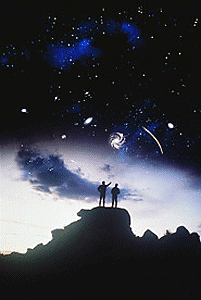Several scientists claim that comets that hit Earth spread life throughout space. Although some of the microorganisms were destroyed due to heat and radiation, a significant part of them survived - and perhaps even reached distant places in the galaxy
24.9.2004
By: Yoram Ored, Galileo
Published courtesy of Galileo

According to their claim, it is possible that comets that hit the Earth during its years of existence caused pieces of soil containing microorganisms to be splashed from the Earth into space, and in the process gradually spread life throughout our galaxy, even to its most distant edges. According to the scientists, although some of the microorganisms were destroyed due to heat and radiation, a significant part of them survived. Our solar system and with it the Earth, orbit the center of the galaxy once every two hundred and forty million years; During this cycle the solar system passes in the vicinity of other planetary systems and therefore the spread of life throughout the galaxy is possible.
This claim strengthens the theory of panspermia, which presents the claim that life did not originate on Earth itself, but came to it from space. The panspermia theory was developed by astronomer Fred Hoyle and Chandra Wickramasingh starting in 1974.
interplanetary dust
One of the processes that may have aided the spread of life by comets (if it did occur) is the erosion of rock and soil by interplanetary dust, dust found between the planets. Accretion helped dispersal by breaking the blocks of rock and earth into tiny pieces and the solar wind pushed them out of the solar system, carrying life within them. It is estimated that, due to this push, these tiny pieces could over the years leave the confines of our solar system.
This opinion led the scientists to hypothesize that our solar system is currently in the center of a kind of "life disc" that is expanding, a disc that is a kind of cloud of tiny pieces of matter that carry with them life in the form of microorganisms that are in a state of dormancy. The diameter of the disc may reach thirty light years and maybe even more. During the existence of the Earth, there have already been dozens of great approaches of our solar system to sun-forming nebulae, from which planetary systems were later formed. These approaches allowed microorganisms to penetrate into such nascent solar systems, right in the process of their formation.
Until the end of the last century, there was a state of uncertainty about the question of whether other suns, besides ours, were also surrounded by their own planetary systems and, if so, to what extent planetary systems were a common phenomenon in the vastness of space. In recent years (since the nineties of the twentieth century), the answer to this question is becoming clearer with the discoveries of more and more planetary systems. So far dozens of planets have been discovered. Planetary systems turn out to be a common phenomenon in the universe. Are planets capable of sustaining life on their surface also a common phenomenon?
If indeed so, the scientists claim, it is possible that the process of dispersal of life through this mechanism (the disk of life that causes the dispersion of microorganisms from Earth to solar systems in the making), has so far "glued" more than ten billion of the stars of our galaxy, the Milky Way galaxy, during its existence.
